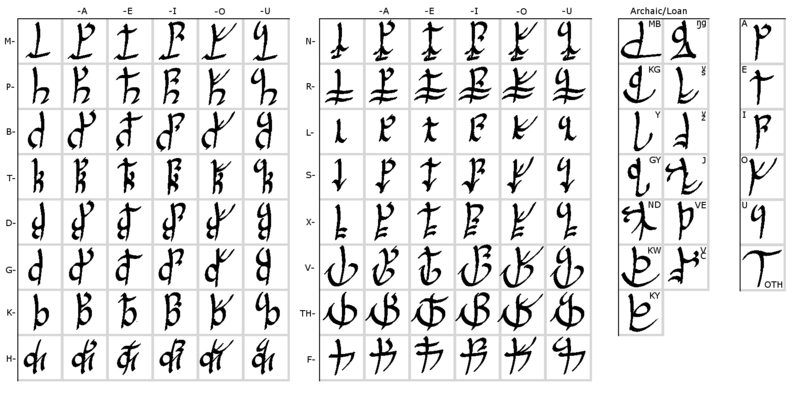The Arangothian Alphabet
Overview of the Arangothek Script
Characters in the Arangothian script combine a "stem" and one or more "mark" strokes. A consonant mark being placed at the bottom of a stem, and that of a vowel being placed at the top. The stem of a character can include both a vowel and consonant to create a syllable. The script distinguishes the following characters:
- 6 Singular vowels
- 16 Singular consonants
- 80 Syllabic consonant-Vowel Unions
- 13 Archaic and/or loan characters
- Of which includes characters meant for pronunciation/transliteration of other languages
- The rare union DX is included to approximate a J sound
- The archaic VE character has been replaced by the more standardized union of V and E in all modern publications
The Arangothek Script
Reading Arangothek
The G in the Arangothian is always pronounced hard; the letters DX represent a J or soft G sound. It is sometimes written as a compound character that combines the marks for D and X onto a single stem. There is no distinguishable difference of K, C and CK in Arangothek thus facilitating the use of K in all instances of the referenced characters.
The vowel OTH is used exclusively at the ending of words and not in any other instance.
The Arangothian script indicates a new word by placing a dot over its first character. Doubled consonants are indicated by a line written above the character. You can see both practices below, in the phrase "Arlok ul-Dorn, Gossath ul Arangoth." (Arlok, son of Dorn, King of Arangoth)
(Broken down, the characters in the above image read: A-R-LO-K U-L DO-R-N GO-SSA-TH U-L A-RA-N-GOTH)
Note that Arangothian on its most basic level isn't written in the Latin alphabet but in a script of its own. What that means is that there's nothing even vaguely "official" about any particular spellings of Arangothian words or names.
For an audible idea of the "sound" of spoken Arangothek, try listening to some of the files in the phrasebook.
A further note on pronunciation and spelling
And if people are unhappy with the sound of "Arangothian", it would do no great violence to it to substitute other sounds for those that are objectionable. For example, personally I pronounce the sound "X" either as "sh" or "zh" whenever it appears in a word or name. For me it would make just as much sense to write "Menshruc" or "Mengerook" as Menxruk, or "Nadeesha" or "Nedygea" for the feminine name Nedixe. You don't have to use the names on the list for your character to be an "authentic" Arangothian; there have been plenty of characters with names that don't appear on this list.
(As a very, very rough rule, male names frequently end in -TH, and female names frequently end in -ESSA if you need to make up a name quickly.)
Letter symbology in Arangothek religion
The character in the Arangothian alphabet that stands for the letter V (first letter of van, the word for good) is also used a symbol, though this is a fairly recent development. It is frequently used in religious jewelry, carved into stone in religious sites, or used in combination with other symbols. The Arangothian letter R (for Ruk) is a common symbol for Menxruk cultists, and used as the opposite of the "V" for "good".
